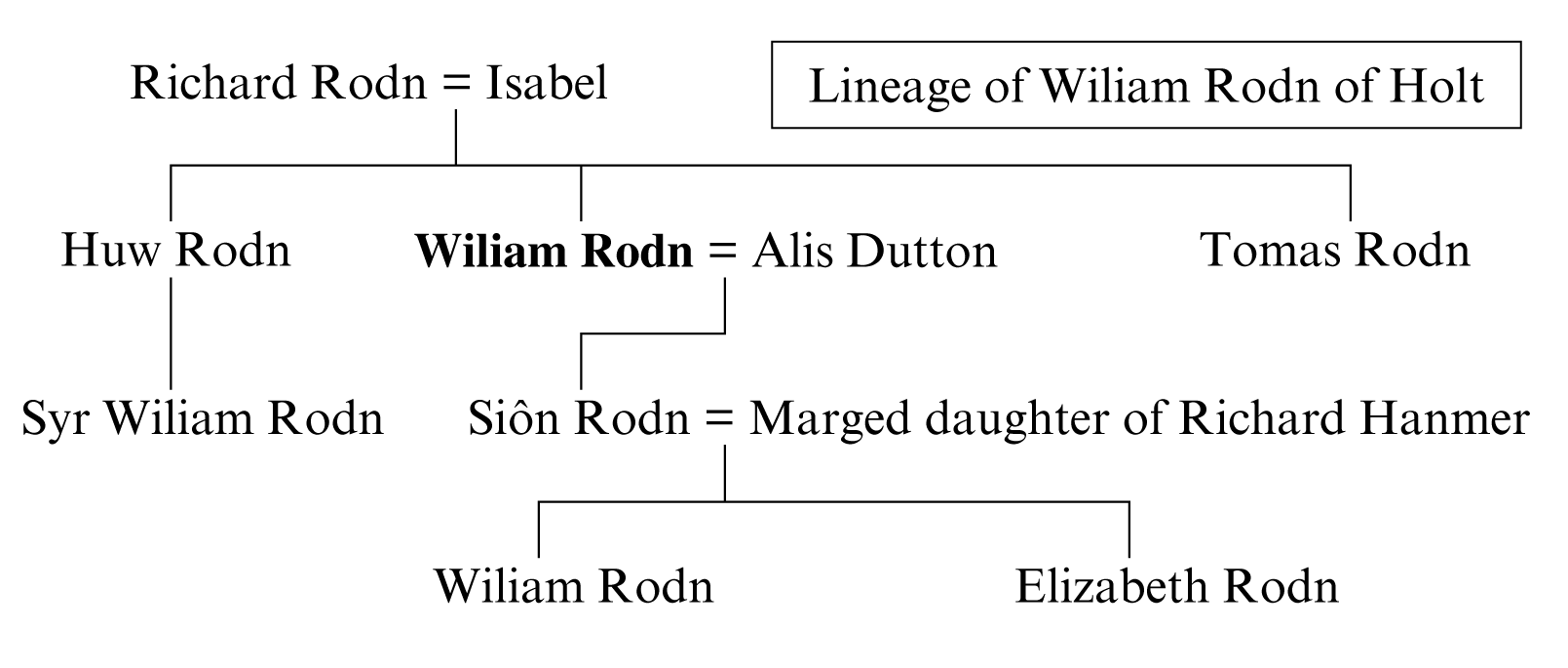Guto composed a poem to request a sallet from Wiliam Rodn (or William Rodon) on behalf of Dafydd Bromffild (poem 73). No other poems for him have survived.
Lineage
Although Guto does not mention Wiliam’s ancestors, his lineage has survived in the manuscripts. The genealogical table below is based on WG2 ‘Roydon’ and HPF iii: 111–12.

Lineage of Wiliam Rodn of Holt
His career
Guto calls Wiliam a rhysyfwr ‘receiver’ (73.17), and Gruffudd Hiraethog also calls him the ‘red receiver’ in the genealogical section of Pen 135 (1556–64): wilem resysyver koch (p. 98), wiliam Rodyn resyver koch (p. 121), Wiliam Rodyn y rresyvwr koch (p. 140).
Further information is provided by Peter Ellis in BL 28033 (c.1625–37) who refers to him as William Roydon Recr of Bromfield (f. 61v). And it is the same ‘William Roydon’, who, in all likelihood, is named in HPF iii: 114 as ‘Collector Antiquaru’ Eschet de Englefeld, 24 Henry VI’ (1445–6); and as ‘Eschetor, 25 et 38 Henry VI’ (1446–7 and 1459–60).
So too the Will’ms Rodon named as one who stood surety for his brother, Thom’ Rodon, in a legal document written in Holt on the first Monday following the Feast of St Luke during the seventh year of the reign of Edward IV, namely 19 October 1467 (Unnamed 1846: 335, where the date is incorrect; HPF ii: 83). Although the exact nature of the document remains unclear, it seems that Dafydd Bromffild (on whose behalf Guto composed his poem for Wiliam), Wiliam Hanmer, Siôn Eutun, Edward ap Madog, Hywel ab Ieuan ap Gruffudd and Morgan ap Dafydd ap Madog, are named in connection with maintaining armed men in Bromfield.
Wiliam’s father, Richard Rodn, is named in HPF i: 392: ‘In 1442, Richard Roydon, of Kent, the ancestor of the Roydons of Is y Coed, is said to have come into Bromfield with the Commissioners of Lord Abergavenny, lord of the moiety of Bromfield, 20th Henry VI’ (see also HPF iii: 111; BL 28033, 61v). Therefore, the Rodns were a family of English immigrants whose patronage of Welsh poetry is comparable with that of other foreign families (such as the Salusburies) in north-east Wales in the fifteenth and sixteenth centuries.
Wiliam Rodn ap Richard Rodn should not be confused with Sir Wiliam Rodn ap Huw Rodn, who was parson of Gresford (HPF iii: 112; CPR 1476–85, 19). Thomas (1908–13, iii: 254) notes that Sir Wiliam was a ‘sinecure rector’ there in 1476, yet according to CPR he was a parson, an important distinction as the earliest example of rheithor ‘rector’ occurs in the nineteenth century (GPC 3053 s.v. rheithor). His grandson, Wiliam Rodn ap Siôn Rodn, in all likelihood, is named in an extent of Bromfield and Yale in 1508 (Palmer and Owen 1910: 217).
Bibliography
Unnamed (1846), ‘Proceedings’, Arch Camb 2: 147–52, 210–15, 335–8
Palmer, A.N. and Owen, E. (1910), A History of Ancient Tenures of Land in North Wales and the Marches (second ed., Wrexham)
Thomas, D.R. (1908–13), The History of the Diocese of St. Asaph (3 vols., Oswestry)





